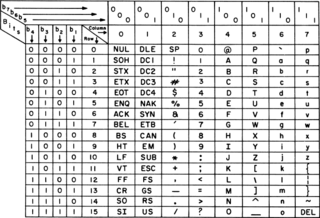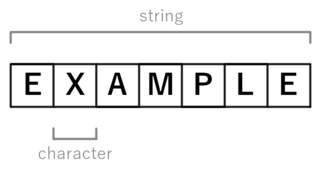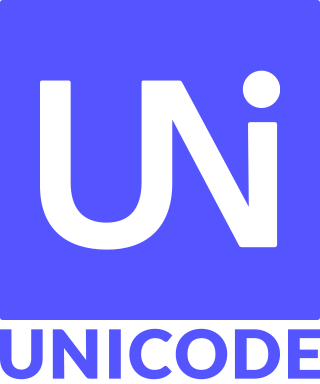Related Research Articles

ASCII, abbreviated from American Standard Code for Information Interchange, is a character encoding standard for electronic communication. ASCII codes represent text in computers, telecommunications equipment, and other devices. Because of technical limitations of computer systems at the time it was invented, ASCII has just 128 code points, of which only 95 are printable characters, which severely limited its scope. Many computer systems instead use Unicode, which has millions of code points, but the first 128 of these are the same as the ASCII set.
The byte is a unit of digital information that most commonly consists of eight bits. Historically, the byte was the number of bits used to encode a single character of text in a computer and for this reason it is the smallest addressable unit of memory in many computer architectures. To disambiguate arbitrarily sized bytes from the common 8-bit definition, network protocol documents such as the Internet Protocol refer to an 8-bit byte as an octet. Those bits in an octet are usually counted with numbering from 0 to 7 or 7 to 0 depending on the bit endianness. The first bit is number 0, making the eighth bit number 7.

Character encoding is the process of assigning numbers to graphical characters, especially the written characters of human language, allowing them to be stored, transmitted, and transformed using digital computers. The numerical values that make up a character encoding are known as "code points" and collectively comprise a "code space", a "code page", or a "character map".
In computing and telecommunication, a control character or non-printing character (NPC) is a code point in a character set that does not represent a written character or symbol. They are used as in-band signaling to cause effects other than the addition of a symbol to the text. All other characters are mainly graphic characters, also known as printing characters, except perhaps for "space" characters. In the ASCII standard there are 33 control characters, such as code 7, BEL, which rings a terminal bell.
Extended Binary Coded Decimal Interchange Code is an eight-bit character encoding used mainly on IBM mainframe and IBM midrange computer operating systems. It descended from the code used with punched cards and the corresponding six-bit binary-coded decimal code used with most of IBM's computer peripherals of the late 1950s and early 1960s. It is supported by various non-IBM platforms, such as Fujitsu-Siemens' BS2000/OSD, OS-IV, MSP, and MSP-EX, the SDS Sigma series, Unisys VS/9, Unisys MCP and ICL VME.

A regular expression is a sequence of characters that specifies a match pattern in text. Usually such patterns are used by string-searching algorithms for "find" or "find and replace" operations on strings, or for input validation. Regular expression techniques are developed in theoretical computer science and formal language theory.

In computer programming, a string is traditionally a sequence of characters, either as a literal constant or as some kind of variable. The latter may allow its elements to be mutated and the length changed, or it may be fixed. A string is generally considered as a data type and is often implemented as an array data structure of bytes that stores a sequence of elements, typically characters, using some character encoding. String may also denote more general arrays or other sequence data types and structures.
Structured Query Language (SQL) is a domain-specific language used in programming and designed for managing data held in a relational database management system (RDBMS), or for stream processing in a relational data stream management system (RDSMS). It is particularly useful in handling structured data, i.e., data incorporating relations among entities and variables.
In biology, taxonomy is the scientific study of naming, defining (circumscribing) and classifying groups of biological organisms based on shared characteristics. Organisms are grouped into taxa and these groups are given a taxonomic rank; groups of a given rank can be aggregated to form a more inclusive group of higher rank, thus creating a taxonomic hierarchy. The principal ranks in modern use are domain, kingdom, phylum, class, order, family, genus, and species. The Swedish botanist Carl Linnaeus is regarded as the founder of the current system of taxonomy, as he developed a ranked system known as Linnaean taxonomy for categorizing organisms and binomial nomenclature for naming organisms.

Unicode, formally The Unicode Standard, is a text encoding standard maintained by the Unicode Consortium designed to support the use of text written in all of the world's major writing systems. Version 15.1 of the standard defines 149813 characters and 161 scripts used in various ordinary, literary, academic, and technical contexts. Many common characters, including numerals, punctuation, and other symbols, are unified within the standard and are not treated as specific to any given writing system. Unicode encodes thousands of emoji, with the continued development thereof conducted by the Consortium as a part of the standard. Moreover, the widespread adoption of Unicode was in large part responsible for the initial popularization of emoji outside of Japan. Unicode is ultimately capable of encoding more than 1.1 million characters.
In telecommunication, the term cancel character has the following meanings:
- A control character used to indicate that the data with which it is associated are in error or are to be disregarded. Exact meaning can depend on protocol. For example:
- A control character used to erase the previous character. This character was created as an unambiguous alternative to the much more common backspace character, which has a now mostly obsolete alternative function of causing the following character to be superimposed on the preceding one.
ANSEL, the American National Standard for Extended Latin Alphabet Coded Character Set for Bibliographic Use, was a character set used in text encoding. It provided a table of coded values for the representation of characters of the extended Latin alphabet in machine-readable form for thirty-five languages written in the Latin alphabet and for fifty-one romanized languages. ANSEL adds 63 graphic characters to ASCII, including 29 combining diacritic characters.
RPG is a high-level programming language for business applications, introduced in 1959 for the IBM 1401. It is most well known as the primary programming language of IBM's midrange computer product line, including the IBM i operating system. RPG has traditionally featured a number of distinctive concepts, such as the program cycle, and the column-oriented syntax. The most recent version is RPG IV, which includes a number of modernization features, including free-form syntax.
The vertical bar, |, is a glyph with various uses in mathematics, computing, and typography. It has many names, often related to particular meanings: Sheffer stroke, pipe, bar, or, vbar, and others.

tr is a command in Unix, Plan 9, Inferno, and Unix-like operating systems. It is an abbreviation of translate or transliterate, indicating its operation of replacing or removing specific characters in its input data set.
The C0 and C1 control code or control character sets define control codes for use in text by computer systems that use ASCII and derivatives of ASCII. The codes represent additional information about the text, such as the position of a cursor, an instruction to start a new line, or a message that the text has been received.
In computing HP Roman is a family of character sets consisting of HP Roman Extension, HP Roman-8, HP Roman-9 and several variants. Originally introduced by Hewlett-Packard around 1978, revisions and adaptations were published several times up to 1999. The 1985 revisions were later standardized as IBM codepages 1050 and 1051. Supporting many European languages, the character sets were used by various HP workstations, terminals, calculators as well as many printers, also from third-parties.

ISO 2047 is a standard for graphical representation of the control characters for debugging purposes, such as may be found in the character generator of a computer terminal; it also establishes a two-letter abbreviation of each control character. The graphics and two-letter codes are essentially unchanged from the 1968 European standard ECMA-17 and the 1973 American standard ANSI X3.32-1973. It became an ISO standard in 1975. It is also standardized as GB/T 3911-1983 in China, as KS X 1010 in Korea, and was enacted in Japan as "graphical representation of information exchange capabilities for character" JIS X 0209:1976.
The Lotus International Character Set (LICS) is a proprietary single-byte character encoding introduced in 1985 by Lotus Development Corporation. It is based on the 1983 DEC Multinational Character Set (MCS) for VT220 terminals. As such, LICS is also similar to two other descendants of MCS, the ECMA-94 character set of 1985 and the ISO 8859-1 (Latin-1) character set of 1987.
The character sets used by Videotex are based, to greater or lesser extents, on ISO/IEC 2022. Three Data Syntax systems are defined by ITU T.101, corresponding to the Videotex systems of different countries.
References
- ↑ DASHER D210 and D211 Display Terminals Users Manual (PDF). DataGeneral. July 1983. pp. D-2 to D-8.
- ↑ "Data General International Character Set". columbia.edu.